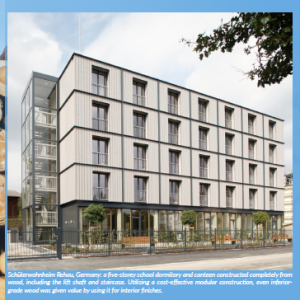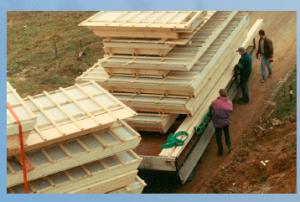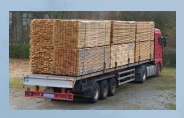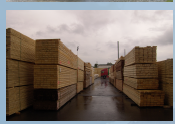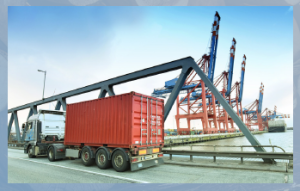In late 2024, a European LIFE project concluded with the goal of expanding the adoption of the environmental label and certification scheme Holz von Hier® (HvH)—or Low Carbon Timber® (LCT), as it is known outside German-speaking countries.
The project goal of introducing HVH or LCT into several European countries was fully achieved. This marks a significant milestone for climate protection in Europe, as it allows for targeted influence on the environmental footprint of supply chains. This development is particularly significant for Europe for two key reasons. First, despite numerous measures in the transport sector (such as biofuels, e-mobility, higher efficiency and EURO standards), CO2 emissions in the European Union (EU) are still not decreasing but continue to rise. Second, internal studies by the World Economic Forum show that around 80% of CO2 reduction potential in the building sector lies in supply chains (Scope 3) and not in the direct influence area (Scope 1 and 2). These potentials have previously been untapped but can now, for the first time, be specifically unlocked using HVH or LCT as a direct and effective tool—even in the public sector, contributing to further improve the overall sustainability of the use of timber for construction.
Ecologically and economically efficient approach
By the end of the project, approximately 74 000 tons of CO2 were saved. The original climate goal target was exceeded, despite significant challenges during the project, including the COVID-19 pandemic and the Russian invasion of Ukraine, which caused major disruptions to supply chains. Additionally, the CO2 savings were calculated conservatively (assuming that at the beginning, only 10% of the raw material sourcing of the participating companies would be switched to HVH). Therefore, the actual CO2 reductions could be considerably higher. Over 3.5 years, the project saved almost seven times as much CO2 per year as the European Green Light Programme did over 10 years (2002–2012). With the completion of the project, the CO2 reduction costs for the EU amount to €6.3/t CO2, which, considering an additional three-year impact period, drops to just €1.6/ton CO2. In comparison, the European Green Light Programme resulted in approximately €11/ton of CO2. The focus on supply chains—particularly on shortening material flows through HVH/LCT—thus contributes efficiently to climate protection, while delivering measurable economic benefits.
Successful integration at the governance level
A key success of the project is the integration of origin certification, such as HVH or LCT, as a strategic tool for climate-friendly supply chains at the governance level. HVH/LCT has already been recognised nationwide in Austria as a sustainability criterion in the Forest Fund and as an environmental label in the national action plan for sustainable procurement (NaBe). In Luxembourg, HVH/LCT is one of the three pillars of the national wood strategy. In Germany, it has become part of the climate protection strategy of several federal states. In Slovenia, HVH/LCT has been incorporated into national guidelines for sustainable public procurement, and HVH/LCT has been integrated into regional procurement guidelines in Italy. These developments demonstrate the high recognition and practical implementation potential of the system in key political and economic areas.
European scalability of climate-friendly regional supply chains
HVH is the first system to make the aspect of short supply chains transferable and scalable, regardless of region, country or company size. This represents a fundamental difference from many regional initiatives in Europe, but actively supports these initiatives. Some of these initiatives are already collaborating closely with HVH. Thanks to the scalability of HVH/LCT and its integration at the governance level, companies of all sizes have joined the HVH/LCT network, from small craft businesses to large multinational corporations. By engaging key players in the supply chain who influence significant parts of the material flows, the project has achieved a sustainable transformation of material flows in supply chains and climate benefits on a scale that was previously not anticipated. Furthermore, the network has already expanded to two additional EU countries.
Support for the implementation of European (environmental) policies
According to the EU Regulation 2023/1115 of the European Parliament and the Council on establishing rules for deforestation-free supply chains (EUDR), which will come into force at the end of 2025, any operator or trader who places commodities like wood or derived products, such as furniture on the EU market, must be able to prove that the products do not originate from recently deforested land or have contributed to forest degradation.
The implementation of this regulation has caused much uncertainty within the industry, especially in 2024, and generally affected the willingness of industry players to adopt new strategies and tools. However, the project was able to respond flexibly to these changes and turn the initially critical situation into a positive incentive. This was achieved by developing an IT interface to the central EUDR platform TRACES, which was comprehensively coordinated with the responsible bodies at the European Commission and national auditing authorities, such as the BLE, and has been successfully tested. This not only increased the acceptance of HVH/LCT within the industry but also supports the further implementation of the EUDR. Additionally, another tool, developed in the project, the ‘Origin’ platform, initially designed as a ‘stakeholder and customer sensitisation tool’ for municipalities, planners and the public, was functionally expanded to support the implementation of the EUDR, as it allows market participants to improve their risk assessment for potential global supply chains.
Product- and batch-specific, realistic assessment of the environmental footprint of supply chains
The EU has been pursuing the concept of the Product Environmental Footprint (PEF) for years with the goal of making products comparable in terms of their environmental impacts. Information on the environmental impact of products is increasingly in demand in strategic instruments such as CSR, the Corporate Sustainability Due Diligence Directive (CSDDD) or the EU Taxonomy. The HVH/LCT environmental footprint developed in the project, based on European PEF principles, for the first time captures the environmental data of the real supply chain of a specific product, including the relevant transport from the factory gate to the construction site. This environmental footprint is accompanied by a benchmark database for the average supply chains of wood products in Europe, providing a basis for comparison. Another accompanying tool is an online supply chain simulator that can model the environmental impacts of complex supply chains. The HVH/LCT environmental footprint, compared to a typical generic EPD, is currently the most accurate life cycle assessment for individual product batches, enabling a realistic determination of CO2 savings from HVH/LCT-certified products.
Integrated into everyday practice
As part of the project, around two million consumers were reached, and awareness of the importance of short supply chains was raised among key target groups and stakeholders. These stakeholders, including chambers of commerce, associations of architects/engineers, as well as municipal umbrella organisations, have been actively involved in the dissemination and implementation of HVH/LCT. Thus, despite long planning phases in the public sector, numerous buildings were tendered and implemented using HVH/ LCT—including Karla, the future tallest wooden skyscraper in Germany. These successes highlight the high acceptance and practical applicability of HVH/LCT tools, even in modern timber construction.
Outlook
The expansion and practical implementation, along with the developed tools, provide a solid foundation for further scaling potential, either through intensified stakeholder engagement in the involved countries or through expansion to additional European countries or the transfer to other materials. Overall, the project not only represents a successful individual contribution to climate protection but also a leap forward by reaching new levels of implementation.
Call for action
The project, however, is not a closed activity with a single impact and restricted circle of stakeholders. Every related stakeholder or group of actors are called upon to get into action and utilise HVH, respectively LCT, in their area of activity:
Enterprises in the timber sector, regardless of their size, are invited to join the network to collectively enhance regional value and supply chains for the benefit of the environment, customers and society.
Architects may set HVH/LCT as a requirement for the timber products used in prospective timber buildings to optimise the carbon footprint of these buildings and support the target of decarbonisation in the building sector.
Public authorities can and should integrate the label into their procurements of wood to advance climate neutrality and foster regional added value. HVH supports public authorities with a climate building pass to assess and prove the carbon savings related to short supply chains.
Governments could utilise HVH/LCT to support climate programmes with practical instruments.
Financial institutions can utilise the offers and taxonomy-related tools of HVH to ensure the sustainability of their investments, delay the occurrence of stranded assets in the building sector, and take appropriate account of the environmental impact of supply chains (Scope 3).
We invite everybody to get in contact with us.
Project summary
The project aims to initiate short-distance regional supply chains of timber products in the business sector and raise the demand for such products in several European countries. This will be achieved by implementing and extending the eco-label Holz von Hier® (or Low Carbon Timber® in non-German-speaking countries) in value chains and raising awareness of the meaning and usability of certified products among private and public customers and professionals.
Project partners
The project will be carried out in Germany, Austria and Luxembourg by the lead partner, Holz von Hier non-profit ltd. Additional partners are ENVIpark in Italy, the Business Support Centre Kranj and the Wood Industry Cluster in Slovenia.
Project lead profile
The project is led by the organisation Holz von Hier, holder of the same-named eco-label. Holz von Hier is an expert in sustainable supply chains, establishing a new eco-label for sustainable timber products and climate-friendly cross-border value chains. It is currently present in six European countries with a network of more than 250 companies using the tools and more than 100 partners at regional, national and international levels.
Project contacts
Project lead, Holz von Hier
Neuenreuth 24, 95473 Creußen, Germany.
Dr Gabriele Bruckner Dr Philipp Strohmeier
Email: info@holz-von-hier.de
Web: www.holz-von-hier.eu www.climate-value-chains.com
ENVIpark (Italy)
Luca Galeasso
SC Kranj (Slovenia)
Helena Cvenkel
Wood Industry Cluster (Slovenia)
Bernard Likaer
funding
The LIFE Climate Value Chains project has received funding from the LIFE programme of the European Union under grant agreement No. LIFE20 CCM/DE/001665.
Figure legends
Schülerwohnheim Rehau, Germany: a five-storey school dormitory and canteen constructed completely from wood, including the lift shaft and staircase. Utilising a cost-effective modular construction, even inferior-grade wood was given value by using it for interior finishes.


